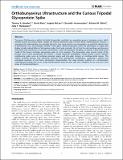Orthobunyavirus ultrastructure and the curious tripodal glycoprotein spike
Abstract
The genus Orthobunyavirus within the family Bunyaviridae constitutes an expanding group of emerging viruses, which threaten human and animal health. Despite the medical importance, little is known about orthobunyavirus structure, a prerequisite for understanding virus assembly and entry. Here, using electron cryo-tomography, we report the ultrastructure of Bunyamwera virus, the prototypic member of this genus. Whilst Bunyamwera virions are pleomorphic in shape, they display a locally ordered lattice of glycoprotein spikes. Each spike protrudes 18 nm from the viral membrane and becomes disordered upon introduction to an acidic environment. Using sub-tomogram averaging, we derived a three-dimensional model of the trimeric pre-fusion glycoprotein spike to 3-nm resolution. The glycoprotein spike consists mainly of the putative class-II fusion glycoprotein and exhibits a unique tripod-like arrangement. Protein-protein contacts between neighbouring spikes occur at membrane-proximal regions and intra-spike contacts at membrane-distal regions. This trimeric assembly deviates from previously observed fusion glycoprotein arrangements, suggesting a greater than anticipated repertoire of viral fusion glycoprotein oligomerization. Our study provides evidence of a pH-dependent conformational change that occurs during orthobunyaviral entry into host cells and a blueprint for the structure of this group of emerging pathogens.
Citation
Bowden , T A , Bitto , D , McLees , A , Yeromonahos , C , Elliott , R M & Huiskonen , J T 2013 , ' Orthobunyavirus ultrastructure and the curious tripodal glycoprotein spike ' , PLoS Pathogens , vol. 9 , no. 5 , e1003374 . https://doi.org/10.1371/journal.ppat.1003374
Publication
PLoS Pathogens
Status
Peer reviewed
ISSN
1553-7374Type
Journal article
Description
This work was supported by the Wellcome Trust (090532/Z/09/Z; 089026/Z/09/Z to TAB; 079810 to RME) and by the Academy of Finland (130750 and 218080 to JTH).Collections
Items in the St Andrews Research Repository are protected by copyright, with all rights reserved, unless otherwise indicated.
Related items
Showing items related by title, author, creator and subject.
-
Virus and interferon : a fight for supremacy : comparison of the mechanisms of influenza A viruses and parainfluenza virus 5 in combatting a pre-existing IFN-induced antiviral state
Xiao, Han (University of St Andrews, 2011-06-06) - ThesisThe Interferon (IFN) family of cytokines are produced in direct response to virus infection and they constitute the first line of defence against virus infection by inducing hundreds of interferon stimulated genes (ISGs) ... -
Molecular studies of the Tacaribe virus nucleoprotein (NP): identification and characterisation of virus-host interactions as novel anti-arenavirus drug targets
Meyer, Bjoern (University of St Andrews, 2014) - ThesisArenaviruses cause an estimated 300,000 – 500,000 infections annually. Currently there is no arenavirus-specific antiviral drug available to treat these infections. This study sought to use the non-pathogenic New World ... -
Structural studies on a hepatitis C virus-related immunological complex and on Ebola virus polymerase cofactor VP35
Fadda, Valeria (University of St Andrews, 2015-11-30) - ThesisHepatitis C virus (HCV) is one of the leading causes of hepatocellular carcinoma worldwide. HCV-neutralizing antibody AP33 recognizes a linear, highly conserved epitope on the viral entry protein E2, disrupting the interaction ...

